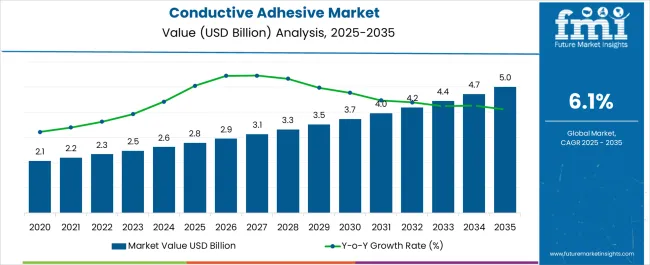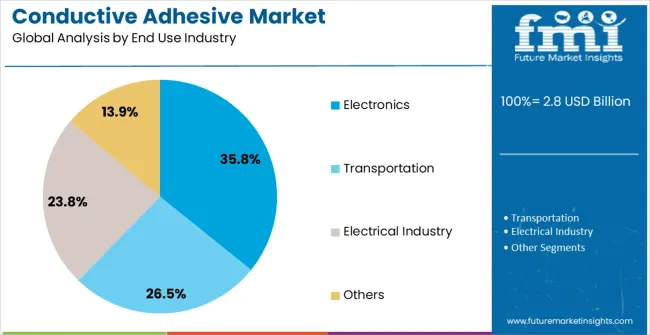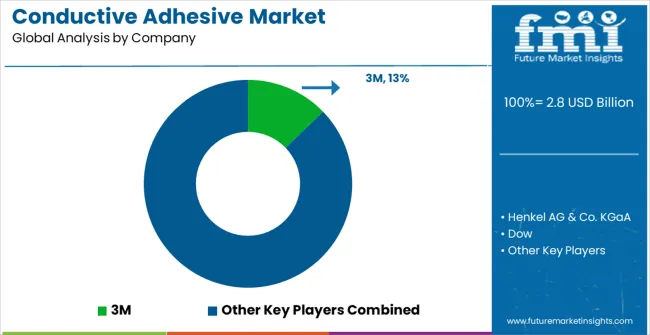The Conductive Adhesive Market is estimated to be valued at USD 2.8 billion in 2025 and is projected to reach USD 5.0 billion by 2035, registering a compound annual growth rate (CAGR) of 6.1% over the forecast period.

| Metric | Value |
|---|---|
| Conductive Adhesive Market Estimated Value in (2025 E) | USD 2.8 billion |
| Conductive Adhesive Market Forecast Value in (2035 F) | USD 5.0 billion |
| Forecast CAGR (2025 to 2035) | 6.1% |
The Conductive Adhesive market is witnessing steady growth, driven by the rising adoption of advanced electronic components, miniaturized devices, and flexible circuit designs that require reliable electrical conductivity. Increasing demand for lightweight, environmentally friendly, and high-performance alternatives to traditional soldering methods is supporting market expansion. Advancements in adhesive formulations, including epoxies, silicones, and acrylics, are enhancing thermal stability, mechanical strength, and electrical conductivity, enabling their use across diverse applications.
Growing integration of electronics in automotive, consumer, and industrial sectors is driving demand for efficient and durable conductive adhesives. The need for precise and automated assembly processes, coupled with increased adoption of wearable and portable devices, further contributes to growth.
Regulatory emphasis on lead-free and environmentally compliant materials is encouraging the replacement of conventional conductive bonding methods with adhesives As manufacturing technologies evolve and product complexity increases, the market for conductive adhesives is expected to expand, with innovations in adhesive chemistry and application techniques facilitating adoption in high-performance and next-generation electronics.
The conductive adhesive market is segmented by product base type, type of conductor, end use industry, transportation, filler material, and geographic regions. By product base type, conductive adhesive market is divided into Epoxy, Polyurethane, Silicone, Acrylic, and Others. In terms of type of conductor, conductive adhesive market is classified into Isotropic Conductive Adhesives and Anisotropic Conductive Adhesives. Based on end use industry, conductive adhesive market is segmented into Electronics, Transportation, Electrical Industry, and Others. By transportation, conductive adhesive market is segmented into Automobiles, Aerospace, and Marine. By filler material, conductive adhesive market is segmented into Silver, Gold, Nickel, Carbon, and Others. Regionally, the conductive adhesive industry is classified into North America, Latin America, Western Europe, Eastern Europe, Balkan & Baltic Countries, Russia & Belarus, Central Asia, East Asia, South Asia & Pacific, and the Middle East & Africa.

The epoxy product base type segment is projected to hold 33.7% of the market revenue in 2025, establishing it as the leading product type. This segment’s growth is driven by the superior mechanical strength, thermal stability, and electrical conductivity offered by epoxy-based adhesives. Epoxies provide excellent adhesion to various substrates, including metals, ceramics, and polymers, making them highly versatile for electronics assembly and industrial applications.
Their ability to withstand thermal cycling, vibration, and environmental stress ensures reliability in critical applications such as printed circuit boards, sensors, and power electronics. The capability to integrate conductive fillers such as silver or carbon further enhances performance while maintaining cost-effectiveness.
Increasing demand for miniaturized and high-density electronic devices has reinforced the preference for epoxy-based conductive adhesives, as they allow precise application without compromising electrical performance With ongoing research in formulation optimization and process automation, epoxy adhesives are expected to retain their market leadership and support broader adoption across multiple end-use industries.

The isotropic conductive adhesives segment is expected to account for 51.4% of the market revenue in 2025, making it the leading type of conductor. Growth in this segment is being driven by the need for adhesives that provide uniform electrical conductivity in all directions, enabling reliable connections in complex circuit designs and high-density packaging.
Isotropic adhesives allow for precise assembly of microelectronic components and flexible electronics, where anisotropic alternatives may be less effective. Their ability to maintain consistent conductivity under mechanical stress, thermal variations, and environmental exposure further enhances adoption.
Integration with automated production processes has improved throughput and reduced defect rates, supporting broader use in consumer electronics, automotive electronics, and industrial devices As electronics become more compact and complex, isotropic conductive adhesives are expected to remain the preferred choice for manufacturers seeking dependable, scalable, and high-performance conductive solutions.

The electronics end-use industry segment is projected to hold 35.8% of the market revenue in 2025, establishing it as the leading application sector. Growth in this segment is being driven by the increasing adoption of wearable devices, smartphones, tablets, and other consumer electronics that require compact, lightweight, and reliable interconnections. Conductive adhesives provide an efficient alternative to soldering, particularly for miniaturized components, flexible circuits, and devices sensitive to high-temperature processing.
The ability to maintain strong mechanical bonds while ensuring electrical performance under thermal cycling and mechanical stress has reinforced their preference in electronic applications. Increasing integration of electronic components in automotive, industrial, and medical devices is further supporting market growth.
Research and development efforts focused on improving conductivity, thermal resistance, and compatibility with diverse substrates are enhancing adoption As the demand for high-performance, reliable, and environmentally friendly electronic assembly solutions continues to rise, the electronics segment is expected to remain the dominant end-use industry in the conductive adhesives market.
Conductive adhesives are materials that allow the flow of electricity along with adhesion and are also known as cold solder. These adhesives are mainly deployed for electrical conductivity and easy repair through adhesion or bonding. Different types of conductive adhesives such as epoxy, polyurethane, silicone, and acrylate are used in numerous specific end use industries.
Among all types, epoxy type of conductive adhesive has a wide range of application and it is expected to hold high share in the global conductive adhesives market mainly due to easy and short production process. In electrical and electronics industry, it replaces the process of soldering.
It has many advantages over conventional soldering process such as lower curing temperature than normal soldering temperature, effective solution for temperature sensitive substrates, more flexible than solder with high capacity to withstand vibrations and lead & solvent free nature.
It is also used in different applications depending on its type of electrical conductivity such as isotropic and anisotropic. Isotropic conductive adhesives conduct electricity in all directions and anisotropic conductive adhesives conduct electricity in only one direction. Isotropic conductive adhesives are used in chip contacting and bonding electrically conductive SMDs and anisotropic adhesives are used in many sensitive structures on circuit boards such as LCD connections and bonding antenna structures on RFIDs.

| Country | CAGR |
|---|---|
| China | 8.2% |
| India | 7.6% |
| Germany | 7.0% |
| Brazil | 6.4% |
| USA | 5.7% |
| UK | 5.1% |
| Japan | 4.5% |
The Conductive Adhesive Market is expected to register a CAGR of 6.1% during the forecast period, exhibiting varied country level momentum. China leads with the highest CAGR of 8.2%, followed by India at 7.6%. Developed markets such as Germany, France, and the UK continue to expand steadily, while the USA is likely to grow at consistent rates. Japan posts the lowest CAGR at 4.5%, yet still underscores a broadly positive trajectory for the global Conductive Adhesive Market. In 2024, Germany held a dominant revenue in the Western Europe market and is expected to grow with a CAGR of 7.0%. The USA Conductive Adhesive Market is estimated to be valued at USD 958.8 million in 2025 and is anticipated to reach a valuation of USD 958.8 million by 2035. Sales are projected to rise at a CAGR of 0.0% over the forecast period between 2025 and 2035. While Japan and South Korea markets are estimated to be valued at USD 128.6 million and USD 88.6 million respectively in 2025.

| Item | Value |
|---|---|
| Quantitative Units | USD 2.8 Billion |
| Product Base Type | Epoxy, Polyurethane, Silicone, Acrylic, and Others |
| Type Of Conductor | Isotropic Conductive Adhesives and Anisotropic Conductive Adhesives |
| End Use Industry | Electronics, Transportation, Electrical Industry, and Others |
| Transportation | Automobiles, Aerospace, and Marine |
| Filler Material | Silver, Gold, Nickel, Carbon, and Others |
| Regions Covered | North America, Europe, Asia-Pacific, Latin America, Middle East & Africa |
| Country Covered | United States, Canada, Germany, France, United Kingdom, China, Japan, India, Brazil, South Africa |
| Key Companies Profiled | 3M, Henkel AG & Co. KGaA, Dow, H.B. Fuller Company, DELO Industrie Klebstoffe GmbH & Co. KGaA, Arkema, Dymax, Heraeus Electronics, Aremco, Creative Materials, MG Chemicals, Master Bond Inc., and HITEK Electronic Materials Ltd |
The global conductive adhesive market is estimated to be valued at USD 2.8 billion in 2025.
The market size for the conductive adhesive market is projected to reach USD 5.0 billion by 2035.
The conductive adhesive market is expected to grow at a 6.1% CAGR between 2025 and 2035.
The key product types in conductive adhesive market are epoxy, polyurethane, silicone, acrylic and others.
In terms of type of conductor, isotropic conductive adhesives segment to command 51.4% share in the conductive adhesive market in 2025.






Full Research Suite comprises of:
Market outlook & trends analysis
Interviews & case studies
Strategic recommendations
Vendor profiles & capabilities analysis
5-year forecasts
8 regions and 60+ country-level data splits
Market segment data splits
12 months of continuous data updates
DELIVERED AS:
PDF EXCEL ONLINE
Electrically Conductive Adhesives Market Size and Share Forecast Outlook 2025 to 2035
Conductive Polymer Coating Market Size and Share Forecast Outlook 2025 to 2035
Conductive Inks Market Size and Share Forecast Outlook 2025 to 2035
Conductive Polymer Packaging Market Analysis - Size, Share, and Forecast Outlook 2025 to 2035
Conductive Silicone Market Size and Share Forecast Outlook 2025 to 2035
Conductive Polymers Market Size and Share Forecast Outlook 2025 to 2035
Conductive Fluted Sheets Market Size and Share Forecast Outlook 2025 to 2035
Conductive Cardboard Market Analysis - Size, Share, & Forecast Outlook 2025 to 2035
Conductive Bags Market from 2025 to 2035
Understanding Market Share Trends in Conductive Inks
Conductive Plastics Market Growth - Trends & Forecast 2025 to 2035
Conductive Foam Market Growth – Trends & Outlook 2024-2034
Conductive Fiber Market Growth – Trends & Forecast 2024-2034
Conductive Ink Printer Market Trends & Industry Growth Forecast 2024-2034
Conductive Textile Market
Anisotropic Conductive Liquid Paste Market Size and Share Forecast Outlook 2025 to 2035
Transparent Conductive Films Market Size and Share Forecast Outlook 2025 to 2035
Stretchable Conductive Material Analysis by Material, Fillers, Stretching Mechanism, Fabrication, Function, Application, End-User and Region - Forecast for 2025 to 2035
Electrically Conductive Coating Market Size and Share Forecast Outlook 2025 to 2035
Adhesives for Electric Vehicle Power Batteries Market Forecast and Outlook 2025 to 2035

Thank you!
You will receive an email from our Business Development Manager. Please be sure to check your SPAM/JUNK folder too.
Chat With
MaRIA